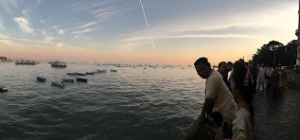
We arrive in Mumbai on New Year’s Eve in 37 C weather (about 100F). It takes almost two hours from the airport to the Taj Mahal Palace hotel in Colaba, South Mumbai, during which every car in the city honks their horn incessantly. It’s chaotic and colorful as we pass slums, high rises condos, crowds on the beach. Finally we reach the hotel — which appears to be under siege by throngs of holiday revelers trying to congregate at the nearby Gateway of India plaza — and are met by the imposing Sikh guards, go through the metal detectors and receive “Namaste” greetings and red dots on our foreheads. The hotel is packed with swirling saris in high-octane colors, and Australian tourists in flipflops and ragged cut-offs, and everything in between. “Dashing through the snow in a one-horse open sleigh” plays incongruously overhead as Indian tourists take pictures of the three white Christmas trees with red bows that have pride of place in the lobby. Despite the crowds, the hotel is gorgeous – packed with antiques, Raj furniture, elegant, old world. Wonderful!
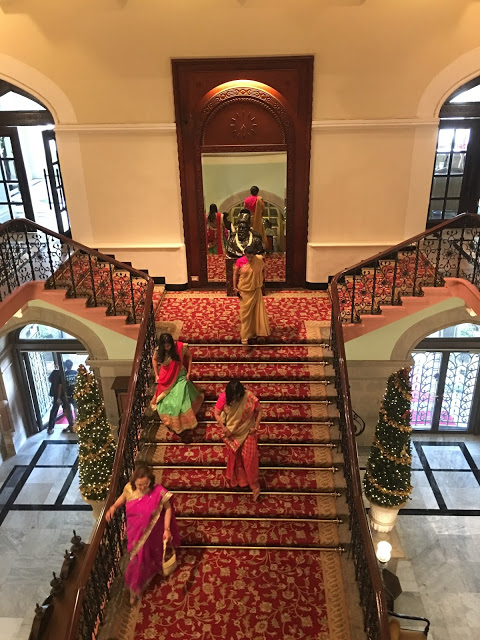
Taj Mahal Palace Grand Staircase
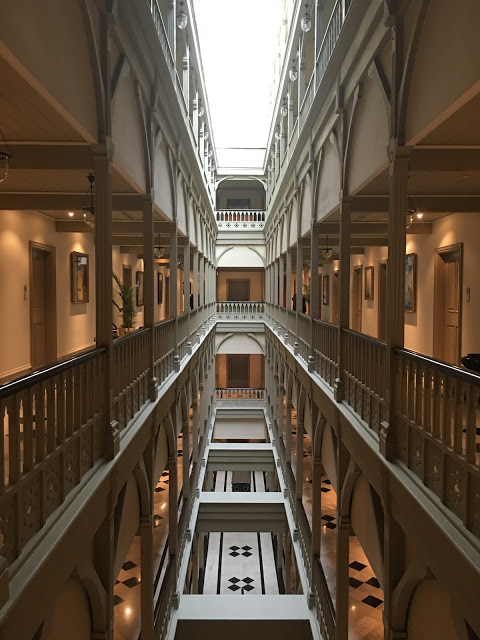
The perfectly symmetrical courtyards.
Mumbai is massively spread out – home to 22 million and more arriving every day. Considered the most modern city in India and an up-and-coming cosmopolitan player in industry, high tech and the arts, we hit the very hot streets and holiday weekend crowds with high spirits – which we will certainly need to negotiate crowds, traffic and hawkers. First observations: streets are surprisingly clean, you can actually walk on the sidewalk, beggars and hawkers are relatively few and almost good-natured. Crossing the street is not life-threatening and traffic lights are more or less obeyed. We walk through the “Fort” area of Kala Ghoda which has become the new art gallery district. It’s still primarily a gritty working district of small shops and retailers with a few gentrified houses and western cafes thrown in. The heat and the swirl of colorful humanity (literally – many colors of saris, many ethnicities, many varieties of local dress) combine to knock us out after only a few hours. We meander through the Jahingar Gallery, find the Knesset Eliyahu Synagogue (Iraqi, mostly 19th century – once a community of 50,000 in Bombay) and keeping going through lanes packed with people and eat lunch at quiet, chilled out Ankur – excellent simple chicken and rice for us, altho Sash is much more adventuresome – prawns, lamb and a hit of red curry.
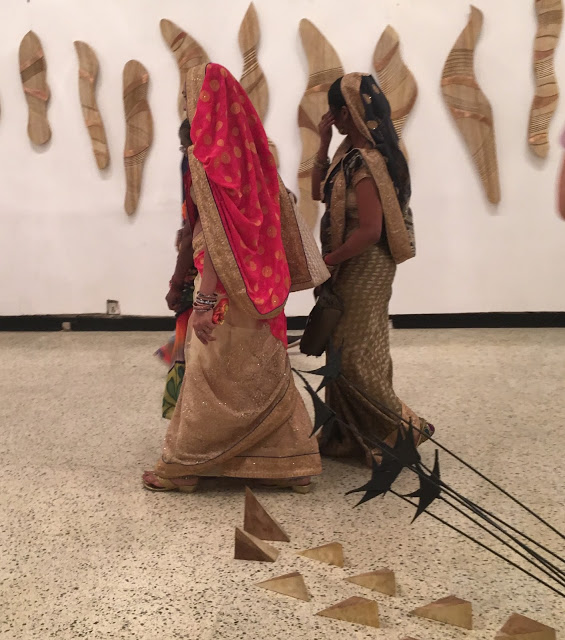
Color in the Jehingar Gallery of Modern Art.
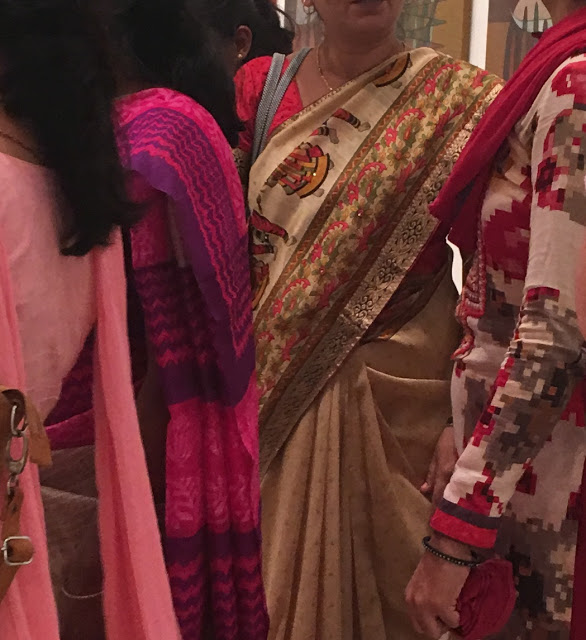
More color…
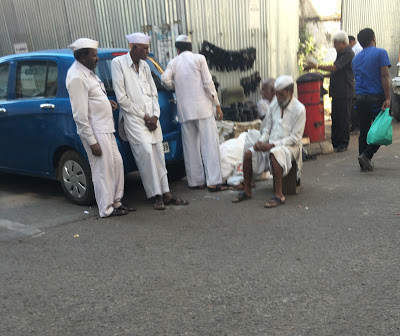
Guys on the street…
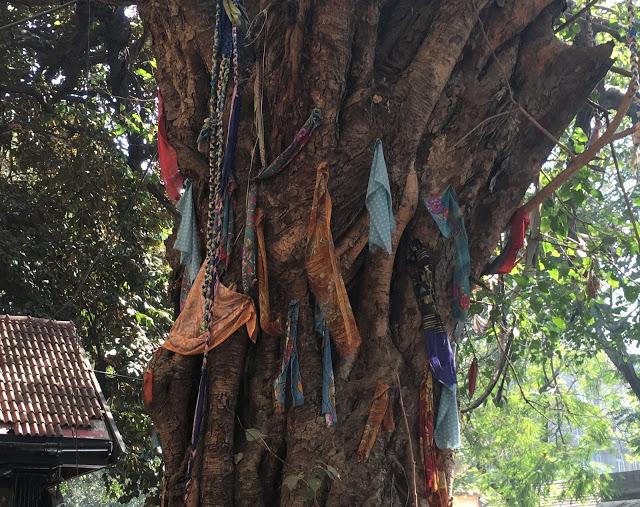
A convenient place to display wares or (just dry stuff?)
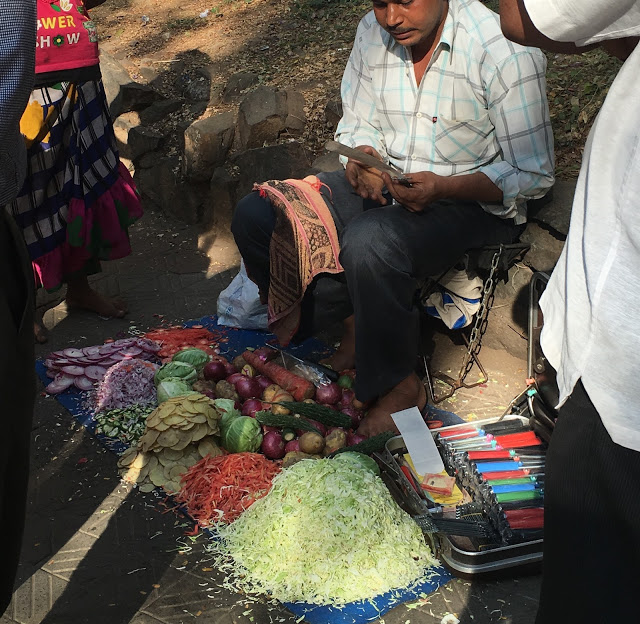
Demonstrating the very best vegetable peeler

At the Knesset Eliyahu Synagogue, Fort District…
Outside the Gateway of India (built in 1911 to welcome King George V), the world is a jumble of fantastically colored saris and tiny women who try to put garlands of jasmine on my wrist (no money no money happy new year!). We end up in a long circuitous route under tight police control to go on to the Gateway of India plaza where we seem to be the only gringos in a very large (again, good natured) crowd. Along the ocean front and up to the main causeway shopping area which is crowded but manageable and hawkers are pretty low-key with the occasional beggar – mostly young women with babies. They are pretty laid-back and nowhere near as aggressive as panhandlers in San Fran – for example. (We do forget from our First World vantage point that we have many of the same problems. Check out the poverty along the Amtrak line from Philadelphia to Baltimore. Who’s on “first”?)
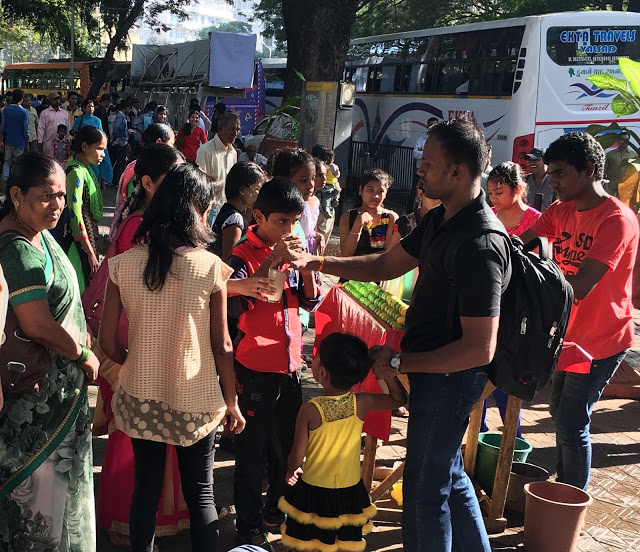
New Year’s crowds
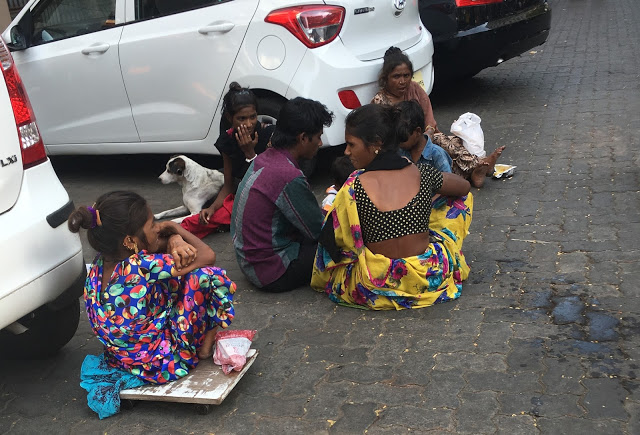
Hanging out
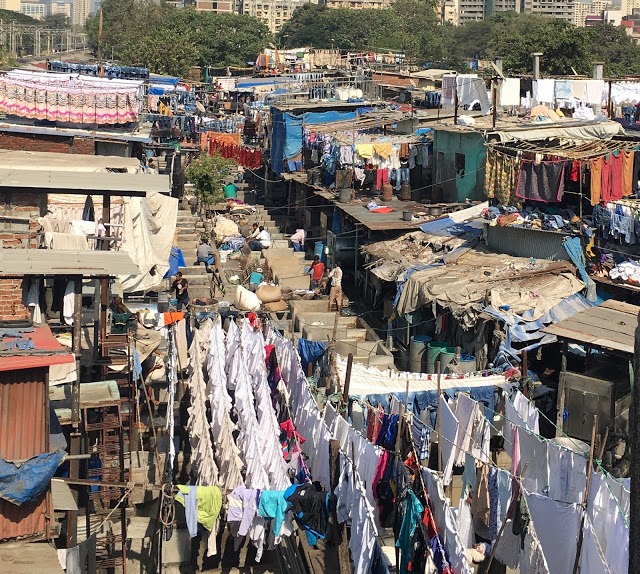
The laundry ghats – all run by men
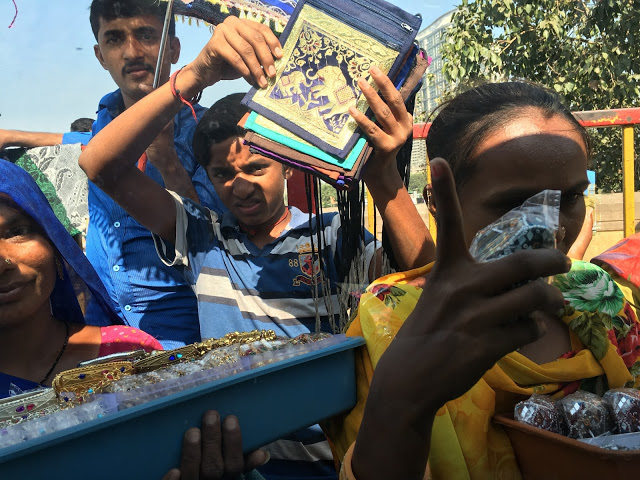
Under siege as we stop at the laundry ghats
Many fascinating regional discussions with Sash: his generation of young people from India are now appreciating what the British left them – 3 generations on from colonialism and its rejection. Same with Kenyans. Iranians in Oman feel that Iran could be the great power of the region if they could get rid of their govt. Social and religious conservatism have become much more prevalent in the muslim world in the last 30 years and it’s only recently that black became the ubiquitous color of women in Islam. Until urbanization, most religious observances and traditions were village based. Suddenly, with mass migration to the cities, local customs were gone and a uniform observance took over. With over a third of the world’s population, India and/vs China will be the interesting challenge. Will India come out ahead? It has managed to overcome multiple potential ethnic rivalries to emerge as a growing powerhouse that is both democratic (although the bureaucracy is legendary)and modernizing at a staggering pace.
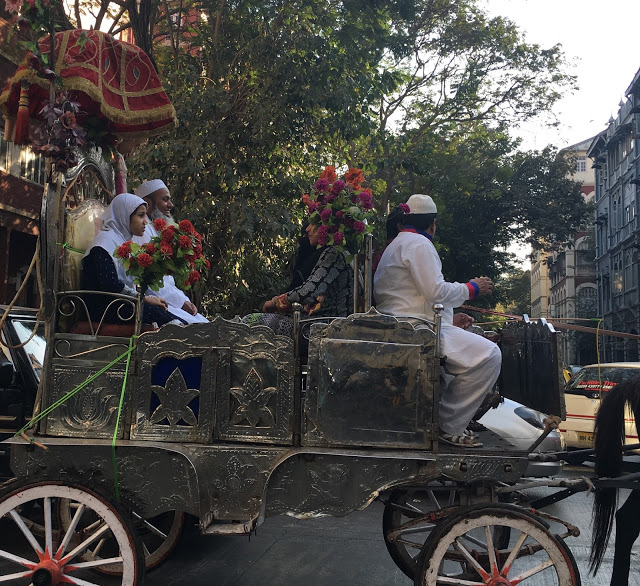
Caleche drivers and decorative carts parade the streets around the Gateway of India.

Cricket on the Maidan – high noon. “Mad Dogs and Englishmen…”
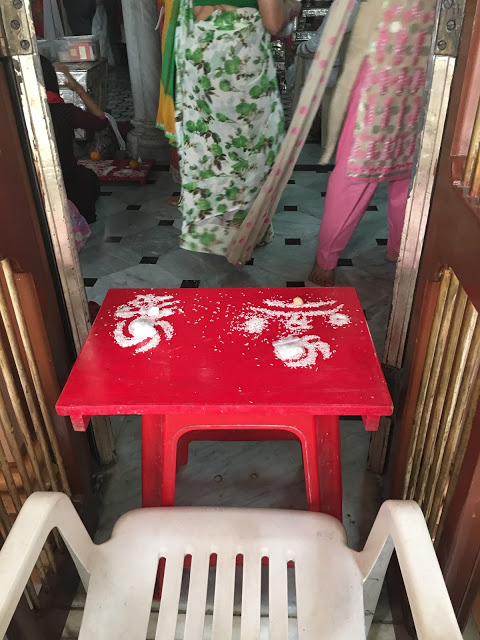
Tiny grains of rice create prayers/designs at the Jain Temple, Malabar Hills.

Pakistan flags flying proudly in the middle of central Mumbai?! Really?
I am most interested in the British Raj architecture – it is amazing that Brits re-created themselves everywhere they went – and they went everywhere. The Raj buildings — Victorian Gothic Indo-Saracen monstrosities (in my opinion) recreated right down to the Mumbai University Campus, the High Court, The Prince of Wales Museum, Big Ben, and the famed Victoria Train Station. But many of them are looking pretty shabby after 100 plus tropical years. Windows decaying, blacked out and crumbling. Possibly headed for the wrecking ball as Mumbai explodes in the future?
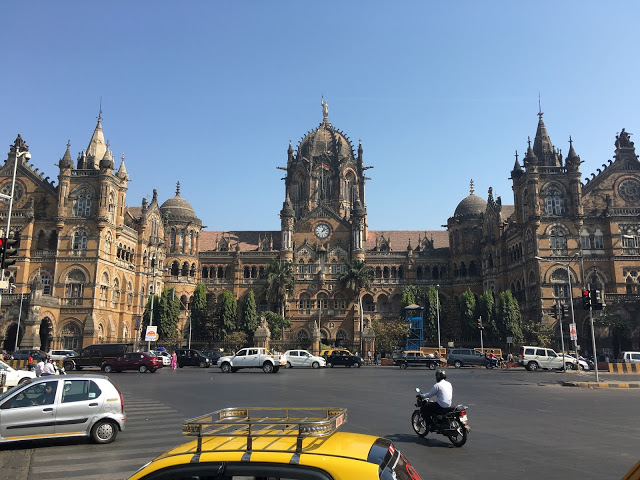
Victoria Station in a rare moment of lesser mayhem..
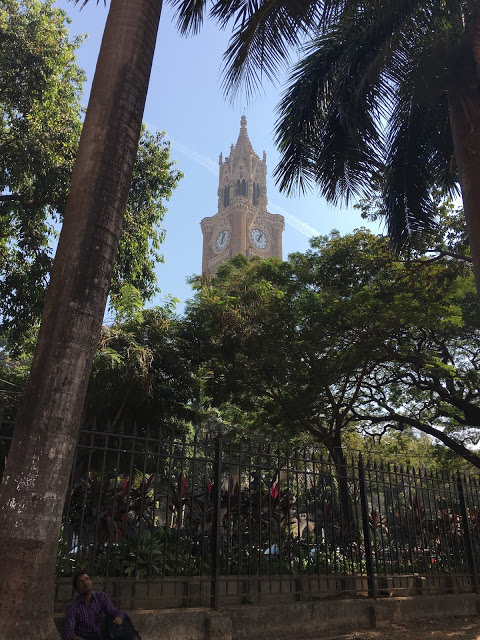
Big Ben in the shadow of palm trees.
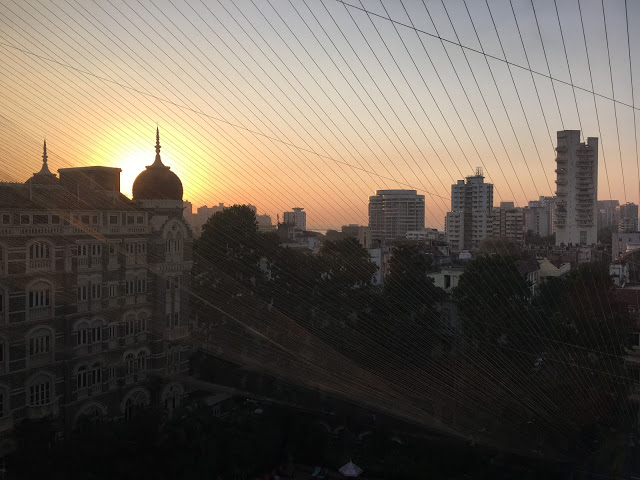
Sunset over the Taj roof.
Clearly we have barely scratched the surface. Are the streets clean because we’re in high rent tourist area and recycling garbage is so profitable? How do people survive in monsoon season, or the full blast of non-winter heat? It is so hot (at this coldest time of year) that you can barely walk for an hour mid-day. (Mad dogs and Englishmen…). Teams of local cricketers play in their crisp whites on the parched maidans. It is so hot that it hurts to watch. Fat dogs sleep unperturbed on the streets everywhere. Skinny, overworked horses pull dressed-up carts of local visitors. Crows – or perhaps ravens – rule the sky. Green parrots squawk in the banyan trees. Vultures circle above Malabar Hill and the Towers of Silence where the Zoroastrian Parsi community (dwindling) bring their dead to be exposed to the elements. (Evidently it takes the vultures about two hours to do their job within the towers and hidden from view.) Kipling’s “If you can keep your head when all about you…” is etched above a doorway. I see signs for Grosvenor House and Lansdowne House – street names of my Montreal childhood. Tiny children carrying their tiny siblings beg in the street. We see a cluster of street kids using plastic sheets as slides to roll down concrete embankments – laughing happily. I compare this with anywhere in Latin America and note that there is no barbed wire separating us and them. There are no armed guards outside every store. There are no clusters of angry (seething) men glowering at women. Everyone seems cheerful and purposeful despite crowds, noise, poverty and heat. And this is what really gets me. Haven’t experienced this in China, or Latin America or anywhere in the Middle East. Sitting on the tarmac at the brand new international airport I stare into the slums made famous in” Beyond The Beautiful Forevers”. Here’s the city’s garbage. – mountains of it. Aongside is a hard-scrabble cricket pitch – uneven and irregular but full of little boys and something like hope. Stay tuned…

Buying stuff I don’t want from a cluster of young ladies
